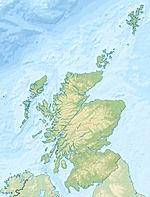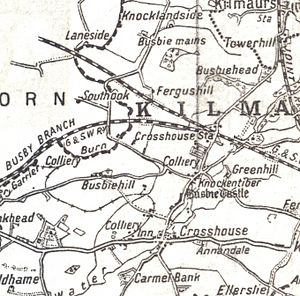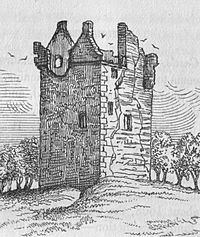Busbie Castle facts for kids
Quick facts for kids Busbie Castle |
|
|---|---|
| Knockentiber, East Ayrshire, Scotland UK grid reference [1] |
|

A photograph of Busbie Castle in 1912
|
|
| Coordinates | 55°37′12″N 4°32′44″W / 55.620028°N 4.545639°W |
| Site information | |
| Controlled by | Mowat |
| Open to the public |
Private |
| Condition | Fragmentary remains |
| Site history | |
| Built | 16th century |
| In use | Until 18th century |
| Materials | stone |
Busbie Castle was a historic building located near Knockentiber, a village in East Ayrshire, Scotland. Knockentiber is about 2 kilometers (1.2 miles) west-north-west of Kilmarnock. The castle stood on a hill, looking over the Carmel Glen and its stream, which flows into the River Irvine.
Contents
History of Busbie Castle
The Castle's Location
Old maps show the area around Busbie Castle. For example, a map from 1775 shows Busbie Castle as a ruin, but still surrounded by its old woodlands. In the 1860s, a map showed that a very old chapel, dedicated to the Virgin Mary, was located close to the castle.
Busbie Castle also had a small group of thatched cottages nearby. These were known as 'Old Busbie'. Over many years, Busbie and Knockentiber grew closer together.
What Busbie Castle Looked Like
The castle was a simple tower, known as a keep. It was about 15 meters (50 feet) tall and roughly 12 meters (40 feet) long by 7.6 meters (25 feet) wide. The main entrance was on the ground floor. Inside, a spiral staircase led up to the first floor, where the main hall was located. The hall had a large fireplace and two window seats, perfect for looking out.
Records from the 1600s show that the Laird (owner) of Busbie's home had six fireplaces. Seven other homes were also connected to the castle and its land.
The castle had been a ruin since at least the 1770s. It was finally taken down in 1949 or 1952 because it was unsafe. There wasn't enough money to fix it. A new building, Busbie House, was built to replace the old castle.
In 1894, a writer named MacIntosh described the castle as a "prominent object" in the landscape. He mentioned seeing gun ports (small openings for guns) and arrow slits (narrow openings for archers). He also noted a carved design that looked like a rope winding around the walls. He believed the castle probably had three floors and was built in the 14th century by the Mowat family.
The Mowat Family of Busbie
The Mowat family owned Busbie Castle for a long time. One notable owner was Charles Mowat of Busbie in the 1500s. He was involved in some conflicts and faced legal troubles. For example, in 1571, he was fined for certain religious practices. He was also involved in a dispute where Sir Neil Montgomerie was killed. As a result, Charles Mowat had to stay in France until Sir Neil's son allowed him to return.
The Mowat family also faced their own challenges. A brother of the Earls of Eglinton once caused trouble for John Mowatt, the Laird of Busby, in the streets of Stewarton.
Later, in 1577, the Charles Mowat who was involved in the Montgomerie dispute was killed by the sons of Lord Ochiltree. His younger brother, James, inherited the lands of Busbie. James's son, also named James, was the last Mowat mentioned in public records as owning the castle.
In 1763, James Ritchie of Craigton took over the lands. His son, Henry, inherited them in 1799. Eventually, the estate passed to William Wallace of Busbie and Cloncaird. In 1661, Hugh, Earl of Eglinton, also inherited parts of the Busbie lands.
The Legend of the Sabbath
There's a famous story about the downfall of the Busbie family. A minister named Mr. Welsh of Ayr warned the laird of Busbie several times. The laird had a custom of inviting guests to his house on Sundays and playing games like football, which was considered wrong on the Sabbath (Sunday) at the time.
Mr. Welsh predicted that the Busbie family would face misfortune. Even though the laird was very rich, bad luck kept happening until he had to sell his estate. When he handed it over to the new owner, he reportedly said with tears in his eyes, "Now Mr. Welsh is a true prophet." This laird was the father of Rev. Mathew Mowat of Kilmarnock.
Busbie Mill
The current Busbie farm used to be a mill. Old maps from 1860 show it with a clear millrace (a channel for water) and a sluice (a gate to control water flow). Water was taken from the Carmel stream near a place called Busbie Holm and returned to the stream just past the mill. We don't know exactly when the mill stopped working. It was likely connected to the castle and the Lairds of Busbie.





